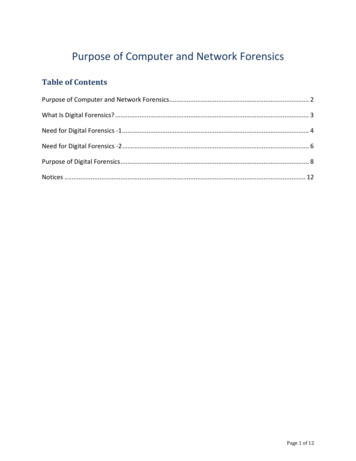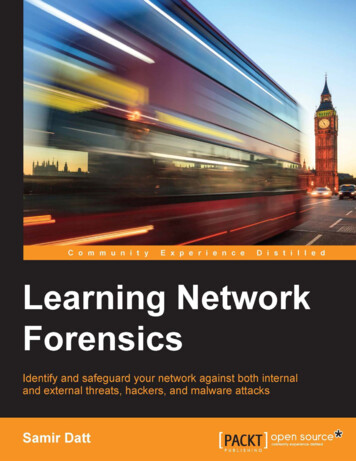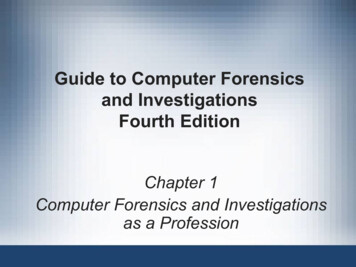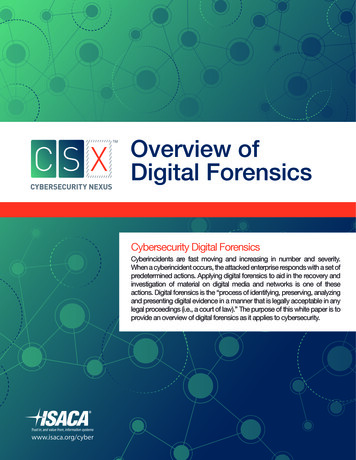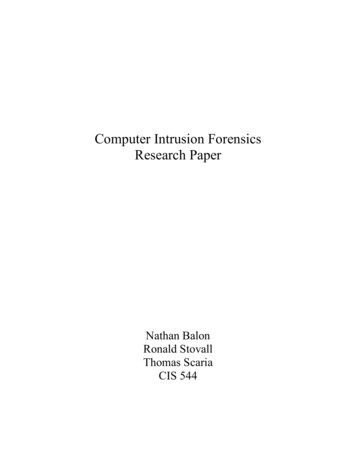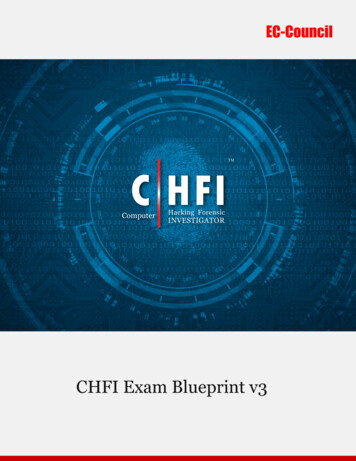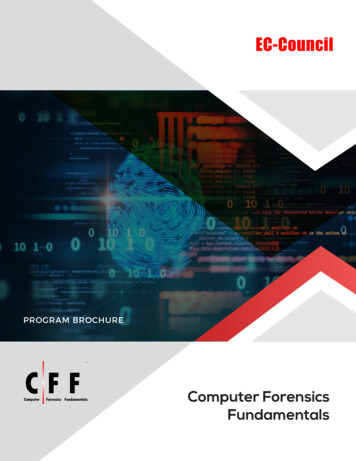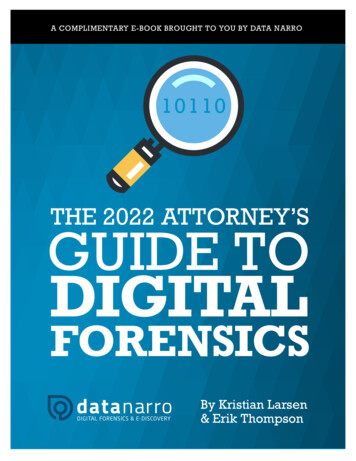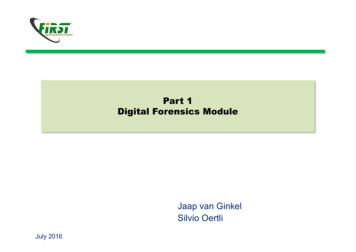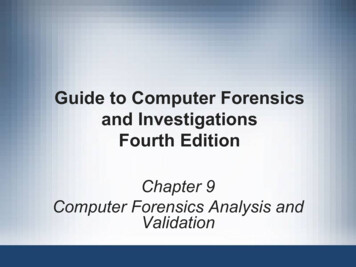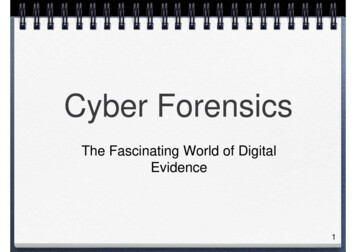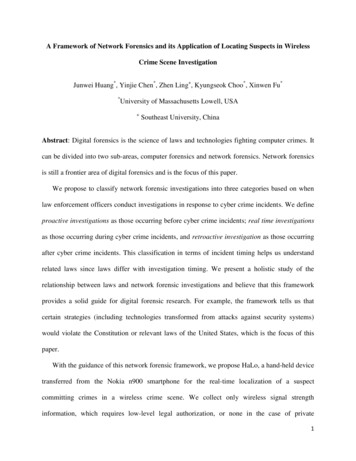
Transcription
A Framework of Network Forensics and its Application of Locating Suspects in WirelessCrime Scene InvestigationJunwei Huang*, Yinjie Chen*, Zhen Ling , Kyungseok Choo*, Xinwen Fu**University of Massachusetts Lowell, USA Southeast University, ChinaAbstract: Digital forensics is the science of laws and technologies fighting computer crimes. Itcan be divided into two sub-areas, computer forensics and network forensics. Network forensicsis still a frontier area of digital forensics and is the focus of this paper.We propose to classify network forensic investigations into three categories based on whenlaw enforcement officers conduct investigations in response to cyber crime incidents. We defineproactive investigations as those occurring before cyber crime incidents; real time investigationsas those occurring during cyber crime incidents, and retroactive investigation as those occurringafter cyber crime incidents. This classification in terms of incident timing helps us understandrelated laws since laws differ with investigation timing. We present a holistic study of therelationship between laws and network forensic investigations and believe that this frameworkprovides a solid guide for digital forensic research. For example, the framework tells us thatcertain strategies (including technologies transformed from attacks against security systems)would violate the Constitution or relevant laws of the United States, which is the focus of thispaper.With the guidance of this network forensic framework, we propose HaLo, a hand-held devicetransferred from the Nokia n900 smartphone for the real-time localization of a suspectcommitting crimes in a wireless crime scene. We collect only wireless signal strengthinformation, which requires low-level legal authorization, or none in the case of private1
investigations on campus. The basic idea of localization is to collect wireless signal strengthsamples while walking. The position where the maximum signal strength is measured will be agood estimate of the suspect device‟s location. The key challenge of accurate localization via thehand-held device is that the investigator has to control its walking speed and collects enoughwireless signal strength samples. We found that digital accelerator on a smartphone and GPS arevery often rough for measuring walking speed. We propose the space sampling theory foreffective target signal strength sampling. We validate the localization accuracy via extensiveexperiments. A video of HaLo is at http://youtu.be/QGhBrt26Q8Y. In this demo, we placed alaptop which was sending out ICMP packets inside one classroom, used HaLo to sniff along thecorridor and finally located the laptop.1. INTRODUCTIONDigital forensics is the science of collecting, preserving analyzing and presenting evidence fromdigital devices (e.g., desktop computers, PDAs, PADs etc.) used and/or accessed for illegalpurposes. The derived evidence needs to be sufficiently reliable and convincing to stand up incourt. Digital Forensics is one of the fastest growing occupations to fight against computercrimes and a practical science for criminal investigations.1There are various classifications of digital forensics based on different criteria. Oneclassification is hardware forensics 2 and software forensics. 3 The former examines hardware1“Digital Forensics”, last modified 15 May 2012, http://en.wikipedia.org/wiki/Digital forensics; Mark Pollitt, “AHistory of Digital Forensics,” in Advances in Digital Forensics VI, ed. Kam-Pui and Sjueet Shenoi. (Boston: Springer,2010), 3-15.2Pavel Gershteyn, Mark Davis and Sujeet Shenoi, “Forensic Analysis of BIOS Chips,” in Advances in Digital ForensicsII, ed. Martin Olivier and Sujeet Shenoi. (Boston: Springer, 2006), 301-314; Pavel Gershteyn, Mark Davis and SujeetShenoi, “Extracting Concealed Data from BIOS Chips,” in Advances in Digital Forensics, ed. Mark Pollitt and SujeetShenoi, (Boston: Springer, 2005), 217-230; Pritheega Magalingam et al., “Digital Evidence Retrieval and ForensicAnalysis on Gambling Machine,” in Digital Forensics and Cyber Crime, ed. Sanjay Geol eds., (Berling Heidelberg:Springer, 2010), 111-121; Paul K. Burke and Philip Craiger, “Xbox Forensics,” Journal of Digital Forensic Practice 1,42
code/architecture and the latter examines electronic document to identify documentcharacteristics, such as authorship. 4 In our paper, we classify digital forensics into computerforensics and network forensics. The former focuses on single alone devices while the latterdeals with networks of devices and dynamic network traffic information. We focus on networkforensics, which is still a frontier area of digital forensics and requires a lot of thinking.In the past three decades, law enforcement specialists and academic researchers haveinvested a great deal of efforts into digital forensics to fight cyber crimes.5 They developed newareas of expertise and avenues of collecting and analyzing evidences. The process of acquiring,examining, and applying digital evidences is crucial to the success of prosecuting a cybercriminal. However, digital forensics is a cross-disciplinary field and it requires knowledge ofboth computing and laws. 6 Academic researchers often lack the required background in therelevant areas of laws. 7 Because of this, their research results often fail to conform to legalregulations. They may be unfamiliar with the real-world problems faced by forensic investigatorsand the constraints involved in solving them. In reality, the incorrect use of new techniques mayresult in the suppression of gathered evidences in court. For example, using specialized(2007): 275-282; Brian D. Carrier and Joe Grand, "A Hardware-Based Memory Acquisition Procedure for DigitalInvestigations," Digital Investigation 1,1 (2004): 50-60.3Andrew Gray, Philip Sallis and Stephen Macdonell, "Software forensics: Extending authorship analysis techniquesto computer programs," In Proceedings of the 3rd Biannual Conference of the International Association of ForensicLinguists (IAFL) (1997): 1-8, Accessed June 27, 2012, doi:10.1.1.110.7627; Juola Patrick, "Authorship Attribution forElectronic Documents," in Advances in Digital Forensics II, ed. Martin Olivier and Sujeet Shenoi, (Boston: Springer,2006), 119-130; de Vel, Olivier et al., "Mining e-mail content for author identification forensics," ACM SIGMODRecord 30,4 (2001): 55-64.4Juola Patrick, Authorship Attribution (Foundations and Trends in Information Retrieval) (Boston: Now PublishersInc., 2008);5Mark, "A History of Digital Forensics," 3-15.6Gary Palmer and Mitre Corporation, "A Road Map for Digital Forensic Research," (Report From the First DigitalForensic Research Workshop (DFRWS), Utica, New York, August 7-8, 2001); Ricci S.C. Ieong,"FORZA – Digitalforensics investigation framework that incorporate legal issues," Digital Investigation 3,supplement (2006): 29-36;Ashley Brinson, Abigail Robinson and Marcus Rogers, "A cyber forensics ontology: Creating a new approach tostudying cyber forensics," Digital Investigation 3,supplement (2006): 37-43.7Robert J. Walls et al., "Effective digital forensics research is investigator-centric," Proceedings of the 6th USENIXconference on Hot topics in security, (Berkeley: USENIX Association, 2011): 11-11.3
technology to obtain information without warrants may violate the Fourth Amendment, and theevidence gathered may therefore suppressed in court.8Since the first Digital Forensics Research Workshop (DFRWS) in 2001, numerousframeworks for digital forensics have been proposed to guide research and investigation.9 Theseframeworks are not uniform. However, there are certain commons to most frameworks, such assystematic evidence collecting procedures.10 It is also agreed that different laws are constrainedto different areas (e.g., military, private entities, law enforcement). 11 Nevertheless, mostframeworks focus on technical details rather than detailed laws to guide research andinvestigation. In reality, due to the legal constraints, many available strategies are not practicalfor law enforcement. As a result, legal restrictions may preclude several criminal investigations.In this paper, we integrate the framework of network forensics with actual laws in order tobuild a bridge between academic research and law investigation. To better assist lawenforcement and make research practical, detailed laws are considered in our framework. Fromthe view of law enforcement, we classify digital forensic investigations into three parts based onwhen law enforcement officers conduct investigations in response to crime incidents. We define8Robert,”Effective”, 11-11; Kyllo v. United States, 533 U.S. 27 (2001).Gary, “A Road”, 2001; Mark Pollitt, "Computer Forensics: an Approach to Evidence in Cyberspace," in NationalInformation Systems Security '95 (18th) Proceedings: Making Security Real, ed. DIANE Publishing Company (Darby:DIANE Publishing, 1996): 487-492; Mark Reith, Clint Carr and Gregg Gunsch, "An Examination of Digital ForensicModels," International Journal of Digital Evidence 1,3 (2002), Accessed June 28, /ijde/articles.cfm?action article&id A04A40DC-A6F6-F2C198F94F16AF57232D; Erbacher, Robert F., Kim Christensen and Amanda Sundberg, "Visual Forensic Techniques andProcesses," Proceedings of the 9th Annual NYS Cyber Security Conference Symposium on Information Assurance(2006): 72-80; Karen Kent et al,"Guide to Integrating Forensic Techniques into Incident Response," NIST SpecialPublication NIST-SP (2006): 800-86.10Ricci, “FORZA”, 2006; Pollitt, Mark, "Six blindmen from Indostan," (Slide presented in the First Digital ForensicResearch Workshop (DFRWS), Utica, New York, August 7-8, 2001); Beebe, Nicole Lang and Jan Guynes Clark,"Ahierarchical, objectives-basedframework for the digitalinvestigationsprocess," Digital Investigation 3,2 (2005):147-167; Mark, "Computer Forensics," 1996; Mark Reith, "An Examination,"2002; Robert, "Visual,"2006; KarenKent,"Guide," 2006.11Sarah Mocas, "Building theoretical underpinnings for digital forensic sresearch," Digital Investigation 1,1 (2004):61-68; Gary, “A Road”, 2001; Ricci, “FORZA”, 2006; Mark, “Six”, 2001; Ashley, "A cyber," 2006.94
proactive investigations12 as those occurring before crime incidents; real time investigations asthose occuring during crime incidents,13 and retroactive investigations as those occuring aftercrime incidents. This classification in terms of incident timing helps us understand related lawssince laws are different if the investigation timing is different. It is derived from our carefulstudy of traditional crime investigations, constitutional and statutory laws and due processes.Currently, most law enforcement investigations are proactive/retroactive investigations. Realtime investigation is a critical issue for law enforcement.In this paper, we first present a refined framework of network forensics with the Constitutionand laws of the United States. Under the guidance of the framework, we developed a wirelessnetwork forensic tool HaLo (Hand-held forensic Localization kit) for law enforcement in realtime investigation. HaLo is transformed from a Nokia N900 smartphone and locates a suspecttarget in a building with received WiFi signal strength (RSS) while the suspect is committing acrime. We collect only wireless signal strength information, which requires low-level legalauthorization, or none in the case of private investigations on campus. The basic idea oflocalization is to collect wireless signal strength samples while walking. The position where themaximum signal strength is measured will be a good estimate of the suspect device‟s location.The key challenge of accurate localization via the hand-held device is that the investigator has tocontrol his or her walking speed and collects enough wireless signal strength samples. We findthat digital accelerator on a smartphone gives a very rough estimation of walking speed. GPS isnot appropriate for indoor use or for measuring low velocity such as walking speed. Thus, we12Daniel Allen Ray, Developing a Proactive Digital Forensics System (Alabama: University of Alabama, 2007); Gary R.Gordon et al., “Identity Fraud Trends and Patterns: Building a Data-Based Foundation for Proactive Enforcement”(Technical Report submitted to Bureau of Justice Assistance, Washington, D.C. 2007);13Swagatika Prusty, Brian Neil Levine and Marc Liberatore, "Forensic Investigation of the OneSwarm AnonymousFilesharing System," CCS '11 Proceedings of the 18th ACM conference on Computer and communications security(2011): 201-214; Marc Liberatore, Brian Neil Levine and Clay Shields, "Strengthening forensic investigations of childpornography on P2P networks," Co-NEXT '10 Proceedings of the 6th International Conference 19 (2010): 1-12.5
propose an effective wireless sampling theory for HaLo in forensic localization in a wirelessnetwork crime scene investigation. We validate the localization accuracy via extensiveexperiments. Our research on effectively sampling RSS fills the missing theory of using handheld devices for accurate localization. To date, no research has answered the question of howslow we should walk in order to collect enough RSS samples for accurate localization. Thispaper answers this very question.The rest of this paper is structured as follows. Related work is introduced in Section 2.Section 3 details the refined framework of network forensics. In Section 4, we introduce HaLo,provide the localization algorithm and present the experimental results. We conclude the paper inSection 5.2. RELATED WORKDue to space limitation, we only review existing work most related to our paper.2.1Digital Forensics(Andrew et al. 1997) applied authorship analysis techniques to computer program code in thearea software forensics. They proposed several principal aspects of authorship analysis. (Juola2006) made a contribution on software forensics by identifying the authorship of electronicdocuments rather than traditional paper documents. By mining properties and styles fromelectronic documents, people may identify the authorship characteristics of a document.In hardware forensics, (Pavel et al. 2006) found BIOS can contain hidden information andintroduced how to extract concealed information from BIOS. (Paul and Philip 2007) found Xboxconsoles can be modified to run malicious codes and developed tools to extract such informationfor forensic investigation. (Pritheega et al. 2010) retrieved information from non-volatile6
EPROM chip embedded in gaming machines for evidence recovery. (Brian and Joe 2004)proposed a hardware-based procedure to obtain information from volatile memory.(Mark 1996, 2001) initialized an abstract framework for digital forensics and provided ahistorical overview of digital forensics.14 (Sarah 2004) identified three investigation entities: lawenforcement, military and business enterprise. She built a common process for each entity. Butshe recognized that the participating events, constraints and outcomes could be different. (Ricci2006) involved laws in digital forensic framework. However, he only included the abstract lawnotion in his framework rather than detailed laws. Later, (Ashley, Abigail and Marcus 2006)proposed more detailed frameworks for digital forensics with law issues. But they did notaddress detailed laws for academic researchers and law enforcement investigators. (Nicole andJan 2005) proposed an objectives-based framework for digital forensic processes. (Brian andEugene 2004) presented a simple framework for the digital investigation process that is based onthe causes and effects of events, and later they used a mathematical model to presentframeworks/classifications for digital forensic investigation.15 (Wei 2004) proposed a frameworkfor a distributed agent-based network forensics system in DSRWS 2004. Later on (Wei and Hai2005) subsequently designed a distributed agent-based real time network intrusion forensicssystem. (Daniel 2007) devised a proactive forensic system that predicts attacks and changed itscollection behavior before an attack takes place.(Robert et al. 2011) described digital forensics from a forensic investigator‟s point of view.They indicated that without understanding the actual forensic context and constraints, academicresearch has little or no impact in reality. Brian et al. also developed proactive/real time forensic14Mark, “A History”, 2010.Brian D. Carrier and Joe Grand, "Categories of digital investigation analysis techniques based on the computerhistory model," Digital Investigation 3,Supplement (2006): 121-130.157
tools over a public p2p network for law enforcement investigators to apply without legalconstraints.162.2Localization Algorithms on SmartphoneIn our study, we aimed to locate an arbitrary WiFi including APs. (Zengbin et al. 2011) built asmartphone-based system for locating WiFi APs in real time. They implemented the system onAndroid phones. By rotating the smartphone several times in a place and analyzing the signalstrength, they were able to locate the direction of the target AP. The smartphone WiFi adapter istransferred into a directional receiver with the holding human body as a signal shield. (Souvik,Romit and Srihari 2012) modified the idea for indoor environment. They built a system SpinLocrelying on the signal strength of the direct signal path. They extracted the direct signal path fromthe power-delay profile of a link, physical layer information that is exported by the Intel 5300card. They then repeated the same process and achieved the same goal with higher accuracy.3. FRAMEWORK OF NETWORK FORENSICSWe will present the refined framework of network forensics in this section. We first carefullycompare traditional crime investigation and network forensic investigation. We then clarifycertain law terminology and finally build up the framework of network forensics with laws.3.1Traditional Crime Investigation v.s. Network Forensic InvestigationWe present three scenes in each traditional investigation. The first traditional crime investigationscene involves a police officer patrolling on the street and deterring (potential) criminals. Weclassify this process as a proactive investigation (i.e. occurs before a crime incident). Imagine thefollowing scene. A robbery is happening on the street and a police officer sees the robbery, stops16Swagatika, "Forensic," 2011: 201-214; Marc, "Strengthening ," 2010: 1-12.8
it and arrests the criminal. Here, crime is happening. Thus, we call it real time investigation.Now imaging a third scene. The robbery happened and the robber has fled. The police officertalks with the victim or other witnesses and conducts an investigation to determine whathappened. They then eventually arrest the criminal. We call this process as a retroactiveinvestigation.Cyber crime investigation is very similar to traditional crime investigation. Consider thefollowing three similar scenes. In the first scene, the police search a P2P network and try toidentify the owner of illegal material. We call this a proactive investigation as it involvespreparing for the detection of a crime incident. In the second scene, there is a hacker attacking acompany‟s network. A police officer gets the report and monitors the activities on the Internet.The police then trace the activities back to the hacker, if possible, and eventually arrest thehacker. Because the crime is happening during the investigation, we call it a real timeinvestigation. Normally, this type of investigation is used to monitor and preserveincome/outcome traffic during the cyber crime and conduct the traceback process if possible. Inthe final scene, the police get a call after the hacking event. Law enforcement read the logs fromthe IDS and firewall, check the connection logs from local Internet Service Providers (ISPs) andthen try to reconstruct the past session They will eventually track it back to the hacker if possibleand then arrest the hacker. Since the investigation is after the crime incident, we call it aretroactive investigation. The basic framework of network forensic investigation is shown inFigure 1.Academic researchers normally develop tools for law enforcement in different investigations,but often ignore the legal constraints of such tools. Thus, it is difficult for law enforcement to use9
such kind of frameworks in actual investigations. Our framework, however, considers such legalconstraints.Figure 1: Basic Framework of Network Forensic Investigation3.2Terminology and Related Law ResourcesBefore addressing legal constraints in detail, we introduce relevant terminology and related legalresources in this section. Normally, there are two kinds of actions in cyber crime criminalinvestigations: investigations with warrants/court orders/subpoenas and investigations withoutwarrants/court orders/subpoenas. They are governed by two primary law resources: the FourthAmendment to the U.S. Constitution, and the statutory laws codified at 18 U.S.C. (United StatesCode) §§2510 to 2522, 18 U.S.C. §§2701 to 2712, and 18 U.S.C. §§3121 to 3127. Most casesinvolve either a constitutional issue under the Fourth Amendment or a statutory issue under therelated law. In a few cases, they overlap.3.2.1TerminologySubpoena: The process by which a court orders a witness to appear (and sometimes presentinformation) in court and produce certain evidence. For example, law enforcement with a10
subpoena can require the witness ISP to produce connection logs to determine a particularsubscriber‟s identity.Court order: Official judge‟s statement compelling or permitting the exercise of certain stepsby one or more parties to a case. For example, law enforcement can ask an ISP to install apacket-sniffer on its routers to collect all packets coming from a particular IP address toreconstruct an AIM session.Search warrant: A written court order authorizing law enforcement to search a defined areaand/or seize property specifically described in the warrant.In general, the above processes are listed in order of degree of difficulty. For example,applying for a subpoena is much easier than applying for a search warrant. A mere suspicion isenough to apply for a subpoena, while “specific and articulable facts” are needed to apply for acourt order and probable cause is necessary to apply for a search warrant.3.2.2A.Related Legal ResourcesThe Fourth Amendment to the U.S. ConstitutionThe Fourth Amendment is the main constitutional restriction to forensic investigation:“The right of the people to be secure in their persons, houses, papers, and effects, againstunreasonable searches and seizures, shall not be violated, and no Warrants shall issue, but uponprobable cause, supported by Oath or affirmation, and particularly describing the place to besearched, and the persons or things to be seized.”The Fourth Amendment protects people‟s reasonable privacy by limiting government agents‟authority to search and seize without a warrant. Government investigators cannot gather digitalevidence and identify a suspect based on hunch; they must have probable cause.B.Acts in United States Code (U.S.C. )11
The following main restrictions from U.S.C. are also relevant.a)Wiretap Act (Title III)The Wiretap Act,17 18 U.S.C. §§2510-2522, was first passed as Title III of the Omnibus CrimeControl and Safe Streets Act of 1968 and is generally known as “Title III”. It was originallydesigned for wire (see 18 U.S.C. § 2510(1)) and oral communications. The ElectronicCommunications Privacy Act of 1986 (ECPA)18 was enacted by the United States Congress toextend government restrictions on wire taps from telephone calls to include transmissions ofelectronic data by computer.19The Wiretap Act is an important statutory privacy law. Roughly speaking, it prohibitsunauthorized government access to private electronic communications (see 18 U.S.C. §2510(12))in real time.b)Stored Communications ActThe Stored Communications Act (SCA),20 18 U.S.C. §§2701-2712, is a law that was enacted bythe United States Congress in 1986. The SCA is a part of the ECPA. It protects the privacy rightsof customers and subscribers of ISPs and regulates the government access to stored content andnon-content records held by ISPs.c)Pen Register ActThe Pen Register Act,21 18 U.S.C. §§ 3121-3127, is also known as the Pen Registers and Trapand Trace Devices statute (Pen/Trap statute). Generally speaking, a pen register device (see 1817"Wiretap Act," Last modified March 23, 2012, http://en.wikipedia.org/wiki/Wiretap Act."Electronic Communications Privacy Act," Last modified May 24, 2012, http://en.wikipedia.org/wiki/ECPA.19H. Marshall Jarrett and Michael W. Bailie, Searching and Seizing Computers and Obtaining Electronic Evidence inCriminal Investigations (Washington, DC: Office of Legal Education Executive Office, 2009), Accessed June 28, i/Stored Communications 2011,http://en.wikipedia.org/wiki/Pen register#Pen Register Act.1812
U.S.C. § 3127(3)) records outgoing addressing information (such as a number dialed andreceiver‟s email address); while a trap and trace device (see 18 U.S.C. § 3127(4)) recordsincoming addressing information (such as an incoming phone number and sender‟s emailaddress).In general, the Pen/Trap statute regulates the collection of addressing and other non-contentinformation such as packet size for wire and electronic communications. Title III regulates thecollection of the actual content of wire and electronic communications. Both of the two statutesabove regulate the real-time forensics investigations while the SCA statute regulates the staticforensics investigations (e.g., those involving email and account information). The relationshipbetween network forensic investigations and laws is shown in Figure 2.Figure 2: Relationship between Network Forensic Investigation and Laws3.3Reasonable PrivacyOne critical concept in acquiring evidence is reasonable privacy. A person deserves reasonableprivacy if 1) he/she actually expects privacy and 2) his/her subjective expectation of privacy is13
“one that society is prepared to recognize as „reasonable. 22 ‟”. In this subsection, we discusssituations in which people have/do not have reasonable privacy.A.When People have Reasonable PrivacyIn 1967, the United States Supreme Court held that Katz, the defendant, had reasonable privacywhen he entered a telephone booth, shut the door, and made a call. Thus, it was illegal forgovernment agents to obtain the content of the phone call without a warrant, even though therecording device was attached outside the telephone booth, the communication was notinterfered and the booth space is not physically intruded.23 The Supreme Court holds that whenthe defendant shuts the door, his objective expectation is that nobody would hear hisconversation and this action is recognized as reasonable by society. This idea is generallyphrased as “the Fourth Amendment protects people, not places.”24A basic legal issue in digital forensics is whether an individual has a reasonable expectationof privacy of electronic information stored within computers (or electronic storage devices). Theconsensus is that electronic storage devices are analogous to closed containers and people dohave a reasonable expectation of privacy. If a person enjoys a reasonable expectation of privacyof his/her electronic information, law enforcement officers ordinarily need a warrant to “search”and “seize”, or an exception to the warrant requirement before they can legally access theinformation stored inside. Therefore, when researchers invent a new technique, they need todetermine whether this new technique violates a person‟s expectation of reasonable privacy. If itdoes, they may need to re-design the technique in order to help law enforcement avoid searchwarrant requirements by searching for information not subject to privacy expectations.22H. Marshall, Searchin, 2009; EFF.org, “Reasonable Expectation of Privacy,” (Accessed June 28, cy; Katz v. United States, 389 U.S. 347 (1967)23Katz v. United States, 389 U.S. 347 (1967)24EFF.org, “Reasonable”, 201214
B.When People do not have Reasonable PrivacyNormally, individuals can have no reasonable expectation of privacy for information in publicplaces. If a person knowingly exposes information to another person or in a public place, he/shehas no reasonable expectation of privacy on that exposed information.25 For example, two peopleare talking inside a house; they are talking so loudly that everyone walking outside the house canhear. Law enforcement on the street can record this conversation without a warrant, even thoughthis conversation happens inside the house. In the Katz case,26 although Katz‟s conversation wasnot permitted to be recorded without a warrant, Katz‟s appearance or actions (witnessed throughthe transparent glass) could be legally recorded. In other examples (e.g., bank accounts,subscriber information, the telephone numbers), there can be no expectation of privacy since theinformation is knowingly exposed to the service provider. 27 However, that information isprotected by statutory laws.In digital forensics, if people share information and files with others, they normally lose thereasonable expectation of privacy. For example, a person has no privacy if he/she leaves a file ona public computer in a public library; 28 or shares a folder with others. 29 Many cases haveaddressed sharing information and losing reasonable expected privacy, such as sharinginformation and files through P2P software 30 (including anonymous P2P software 31 ), leavinginformation on a public Internet32 and so on.25United States v. Gorshkov, 2001 WL 1024
University of Massachusetts Lowell, USA Southeast University, China. Abstract: Digital forensics is the science . of laws and technologies fighting computer crimes. It can be divided into two sub-areas, computer forensics and network forensics. Network forensics is still a frontier area of digital forensics and is the focus of this paper. We .
